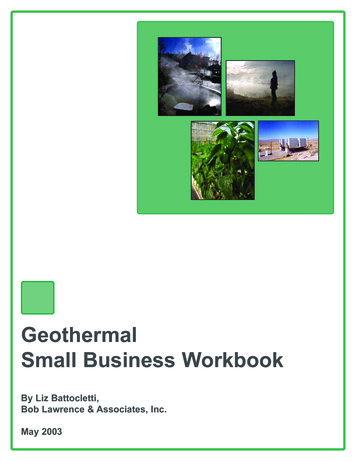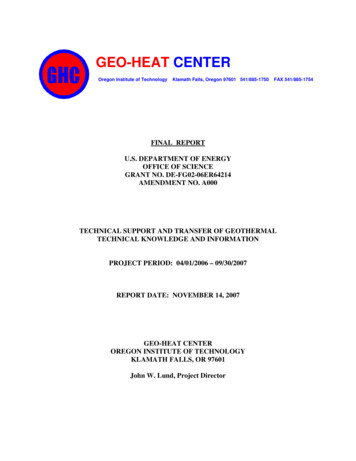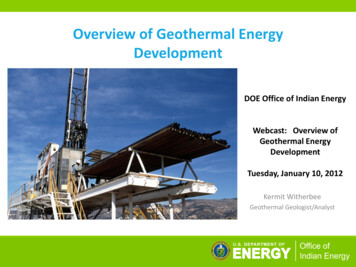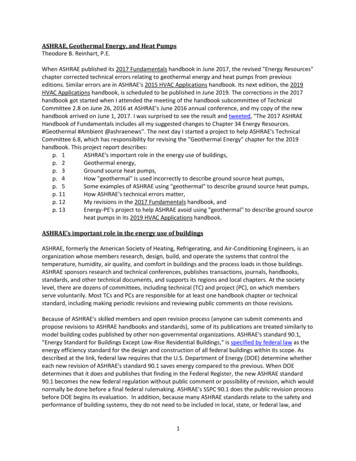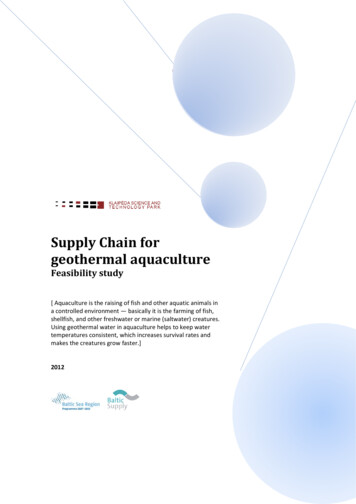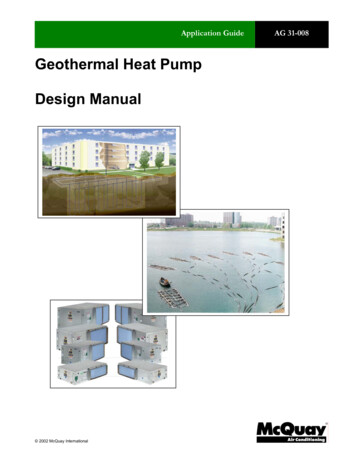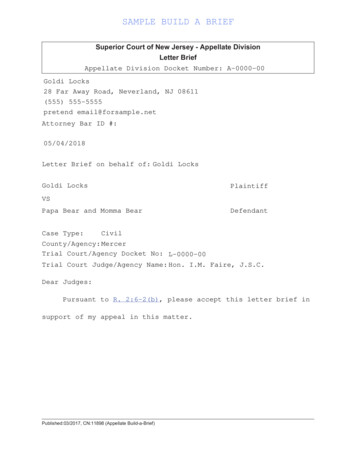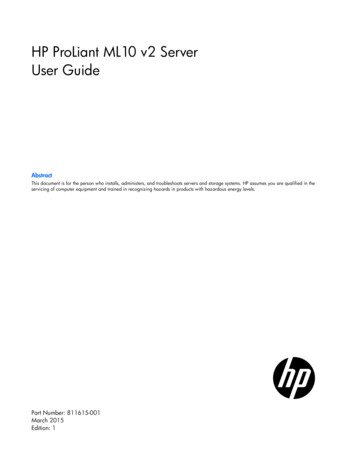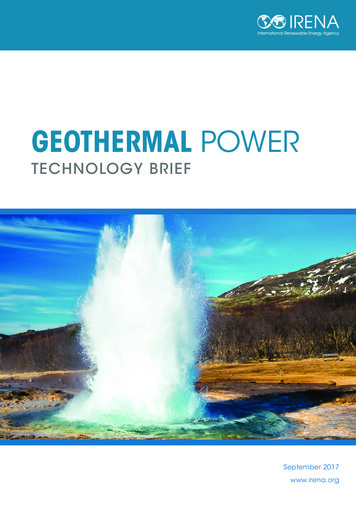
Transcription
GEOTHERMAL POWERTECHNOLOGY BRIEFSeptember 2017www.irena.org
Copyright IRENA 2017Unless otherwise stated, material in this publication may be freely used, shared, copied, reproduced,printed and/or stored, provided that appropriate acknowledgement is given of IRENA as the source andcopyright holder. Material in this publication that is attributed to third parties may be subject to separateterms of use and restrictions, and appropriate permissions from these third parties may need to besecured before any use of such material.ISBN 978-92-9260-036-5 (PDF)CitationIRENA (2017), Geothermal Power: Technology Brief, International Renewable Energy Agency, Abu Dhabi.About IRENAThe International Renewable Energy Agency (IRENA) is an intergovernmentalorganisation that supports countries in their transition to a sustainable energyfuture, and serves as the principal platform for international co-operation,a centre of excellence, and a repository of policy, technology, resource andfinancial knowledge on renewable energy. IRENA promotes the widespreadadoption and sustainable use of all forms of renewable energy, includingbioenergy, geothermal, hydropower, ocean, solar and wind energy, in thepursuit of sustainable development, energy access, energy security andlow-carbon economic growth and prosperity.AcknowledgementsThis brief benefited greatly from reviews by Paul Brophy (EGS Inc.), Colin Harvey(GNS Science), Juliet Newson (Iceland School of Energy), Shigeto Yamada (FujiElectric Co., Ltd.) and Toshihiro Uchida (AIST); as well as reviews and inputs fromDolf Gielen, Gurbuz Gonul, Roland Roesch, Francisco Boshell, Luca Angelino,Michael Taylor, Sean Ratka, Leonore van Velzen and Marta Cioci (IRENA).Contributing authors: Takatsune Ito and Carlos Ruiz (IRENA)For further information or to provide feedback: publications@irena.orgDisclaimerThis publication and the material herein are provided “as is”. All reasonable precautions have beentaken by IRENA to verify the reliability of the material in this publication. However, neither IRENAnor any of its officials, agents, data or other third-party content providers provides a warrantyof any kind, either expressed or implied, and they accept no responsibility or liability for anyconsequence of use of the publication or material herein.The information contained herein does not necessarily represent the views of the Members ofIRENA. The mention of specific companies or certain projects or products does not imply that theyare endorsed or recommended by IRENA in preference to others of a similar nature that are notmentioned. The designations employed and the presentation of material herein do not imply theexpression of any opinion on the part of IRENA concerning the legal status of any region, country,territory, city or area or of its authorities, or concerning the delimitation of frontiers or boundaries.All photos from Shutterstock.
ContentsInsights for Policy Makers .2Highlights .4Process and Technology Status .6Costs .12Potential and Barriers .15References .22Ge othe r m al PowerTechnology B rief1
Insights for Policy MakersGeothermal energy is a type ofrenewable energy which is generatedwithin the earth and can be useddirectly for heating or transformedinto electricity. An advantage ofgeothermal energy over some otherrenewable energy sources is that itis available year-long (whereas solarand wind energy present highervariability and intermittence) and canbe found around the globe. However,for electricity generation, medium- tohigh-temperature resources, whichare usually close to volcanically activeregions, are needed.Geothermal power has considerablepotential for growth. The amountof heat within 10 000 metres of theearth's surface is estimated to contain50 000 times more energy than all oiland gas resources worldwide (Shere,2013). Moreover, there is a strongeconomic case for the deploymentof geothermal energy. The costs forelectricity generation from geothermaltechnologies are becoming increasinglycompetitive, and they are expectedto continue to drop through 2050(Sigfusson and Uihlein, 2015).2G eot h e rma l Powe rTe chnolog y Br ie fDeployinggeothermalenergyhas additional benefits, as it alsocontributes to reduced global warmingeffects and public health risks resultingfrom the use of conventional energysources. Furthermore, the deploymentof geothermal energy helps reduce acountry’s dependence on fossil fuels.As a resource which is naturallyreplenished on a human time-scale,geothermal energy is not impactedby global depletion of resources orby rising fossil fuel prices. Hence,if the full potential of geothermalresources can be realised, this woulddeliver considerable advantagesboth at the national and internationallevels. In addition, compared to fossilenergy resources, geothermal powergeneration brings a number of benefits,such as: lower life-cycle greenhousegas emissions (Figure 1); lower runningcosts; capability to supply baseloadelectricity, flexibility and ancillaryservices to a system; and highercapacity factors.
Figure 1: Estimates of lifecycle greenhouse gas emissionsby power generation sourceElectricity Generation TechnologiesPowered by Renewable ResourcesElectricity Generation TechnologiesPowered by Non-Renewable Median25thPercentileMinimum1,000Single Estimateswith CCS750500-1,250CoalOilNatural GasWind EnergyOcean EnergyHydropowerNuclear Energy-750-1,000Geothermal Energy-500Concentraiting Solar Power-250Photovoltaics0BiopowerGas250* Avoided Emissions, no Removal of GHGs from the Atmosphere-1,500Count ofEstimates222( 4)124428281012612583( 7)24169( 12)Count ofReferences52( 0)26136115493236( 4)1050( 10)Source: IPCC, 2011Global Geothermal AllianceLaunched in December 2015 at the 21st Conference of the Parties to the United Nations FrameworkConvention on Climate Change (COP21), the Global Geothermal Alliance offers an inclusive andneutral multi-stakeholder platform for enhanced dialogue, co-operation and co-ordinated actionamong public, private, intergovernmental and non-governmental actors that share a commonvision of accelerating the deployment of geothermal energy for power generation and direct use.The Alliance has an aspirational goal to achieve a five-fold growth in the installed capacity forgeothermal power generation and more than two-fold growth in geothermal heating by 2030*.More specifically, the Alliance aims to: foster an enabling environment to attract investments in geothermal energy. provide customised support to regions and countries with geothermal market potential. facilitate the exchange of insights and experience among key stakeholders along thegeothermal value chain. identify and promote models for sharing and mitigating risks to attract private investmentand integrate geothermal facilities into energy markets. promote the visibility of geothermal energy in the global energy and climate debates.At present, the Alliance gathers over 70 Member countries and Partner institutions fromgeothermal industry, development partners, international finance institutions and academia.* Based on IRENA REmap 2030 analysisMore information available at www.globalgeothermalalliance.orgGe othe r m al PowerTechnology B rief3
HighlightsProcess and Technology Status - Globalgeothermal power capacity by the endof 2016 totalled 12.7 gigawatts (GW),with annual electricity generationreaching 80.9 terawatt-hours (TWh) in2015 (most recent data), amounting toapproximately 0.3% of global electricitygeneration (IRENA, 2017a). Geothermalelectricity generation relies mainly ontechnologies that exploit conventionalgeothermal resources, such as: drysteam plants, flash plants (single,double and triple), binary plants, andcombined-cycle or hybrid plants.However, as high-quality conventionalresources become harder to access,deeper resources may become accessiblein the future through the developmentof enhanced geothermal systems.4G eot h e rma l Powe rTe chnolog y Br ie fCosts - Geothermal project costs arehighly site-sensitive. Typical costs forgeothermal power plants range fromUSD 1 870 to USD 5 050 per kilowatt(kW), noting that binary plants arenormally more expensive than directdry steam and flash plants. Thelevelised cost of electricity (LCOE) ofa geothermal power plant ranges fromUSD 0.04 to USD 0.14 per kilowatt-hour(kWh), assuming maintenance costs ofUSD 110 per kW per year and a 25-yeareconomic life (IRENA, 2017b).Costs for geothermal technologiesare expected to continue to dropthrough 2050, further improving theirbusiness case and fostering theirgrowth (Sigfusson and Uihlein, 2015).
Potential and barriers - Conservativeestimates set the technical potential forgeothermal power production at 200GW (IPCC, 2011). This potential will onlybe realised if emerging technologiessuch as enhanced geothermal systemscontinue to mature and enable accessto resources that previously wereinaccessible.Other promising opportunities forgeothermal power production comefrom taking advantage of whatotherwise would be wasted heat.These include: retrofitting flash plantswithlow-temperaturebottomingcycles; coupling plants with heatingapplications that rely on waste heat;and exploiting co-produced resources(i.e., fluids that are a by-product ofother industrial processes).The main barrier to further geothermaldevelopment lies in the difficult task ofsecuring funding for surface explorationand drilling operations. This can beaddressed through public financingand the creation of public companiesto exploit geothermal resources. Otherbarriers include environmental, socialand administrative constraints. Forinstance, a project might be delayed dueto lengthy administrative proceduresfor the issuance of licences andpermits, or due to delayed discussionsand negotiations (often of complexcharacter) with local groups. Anotherdifficulty is that different countries mighthave different regulations for performingenvironmental and social impactassessments, which are mandatory inmost cases. Transparent governmentregulationswhichavoidcausingunnecessary project delays are needed.Ge othe r m al PowerTechnology B rief5
Process and Technology Statuslife-cycle greenhouse gas emissionsthan fossil fuel-based generation (IPCC,2011). Geothermal energy can be sourcedfrom virtually everywhere. However,the vast majority of medium- and hightemperature geothermal systems, whichare suitable for power generation, arelocated close to areas of volcanic activity– for example, situated along plateboundaries (subduction zones, such asthe majority of the Pacific “Ring of Fire”),mid-oceanic ridges (such as Iceland andthe Azores) and rift valleys (such as theEast African Rift) or near hot spots (suchas in Hawaii) (Figure 2).Geothermal energy is heat derived withinthe sub-surface of the earth. Water and/or steam carry the geothermal energyto the earth’s surface. Depending on itscharacteristics, the geothermal energy canbe used for heating and cooling purposesor can be harnessed to generate cleanelectricity. Geothermal power generationhas higher capacity factors comparedwith some other renewable energyresources and is capable of supplyingbaseload electricity, as well as providingancillary services for short- and long-termflexibility in some cases. Furthermore,geothermal power generation has lowerFigure 2: Tectonic plates and global geological activityKamchatkan ArcJuan de FucaPlateEurasianPlateJapanese ArcsCascadeArcAleutian PlatePacificPlateAntarctic Plateearthquake activityArcs in the "Ring of Fire"EurasianPlateMVB and CaribbeanPlateCA Arc"RING OF eeth" onoverigding plateSouthAmericanPlateScotia PlateDivergentAdapted from National Park Service (U.S.), 20146G eot h e rma l Powe rTe chnolog y Br ie fTransform
In 2016, the global geothermal installed Table 1: Net installed geothermal powercapacity by country in 2016capacity was 12.7 GW (Figure 3).In 2015, geothermal power plantsCountryCapacity (MW)generated approximately 80.9 TWh, or2 511approximately 0.3% of global electricity USA1 916generation (IRENA, 2017a). As shown in PhilippinesTable 1, the United States (2.5 GW), the Indonesia1 534Philippines (1.9 GW) and Indonesia (1.5Kenya1 116GW) lead in installed geothermal powerNew Zealand986capacity.Global installed capacity additions in 2016amounted to 901 megawatts (MW), thehighest number in 10 years, which wereinstalled in Kenya (518 MW), Turkey (197MW) and Indonesia (95 MW) (IRENA,2017a). With the growing momentumfor utilising these geothermal resources,an increasing number of countriesare showing interest in developinggeothermal 533Costa Rica207El Salvador204Nicaragua155Russian Federation78Papua New Guinea53Source: IRENA, 2017aFigure 3: Global installed geothermal capacity14,00012,70612,00010,000MW8,0008,686 8,9189,8999,139 9,45910,121 10,01110,471 10,74011,22111,8466,0002,0004,0002,00002005 2006 2007 2008 20092010201120122013201420152016Source: IRENA, 2017aGe othe r m al PowerTechnology B rief7
Geothermal Power GenerationThe heat content of a geothermalfield will define the power generationtechnology to be used. Power generationfrom geothermal resources requiresresources with high to medium heatcontent. Geothermal power generationcurrently is based on the following fourtechnology options (Long et al., 2003):Direct dry steam plants - In this case,the conversion device is a steam turbinedesigned to directly use the lowpressure, high-volume fluid producedin the steam field. Dry steam plantscommonly use condensing turbines. Thecondensate is re-injected (closed cycle)or evaporated in wet cooling towers(IEA-ETSAP, 2010) (Figure 4). This typeof geothermal power plant uses steamof 150 degrees Celsius ( C) or higher,and, generally, the steam entering theturbine needs to be at least 99.995%dry (DiPippo, 2015) to avoid scalingand/or erosion of the turbine or pipingcomponents. Direct dry steam plantsrange in size from 8 MW to 140 MW (S&PGlobal Platts, 2016).Flash plants - These are the mostcommon type of geothermal electricityplants in operation today. They aresimilar to dry steam plants; however,the steam is obtained from a separationprocess called flashing. The steam isthen directed to the turbines, and theresulting condensate is sent for re-8G eot h e rma l Powe rTe chnolog y Br ie finjection or further flashing at lowerpressure (IEA-ETSAP, 2010) (Figure5). The temperature of the fluid dropsif the pressure is lowered, so flashpower plants work best with welltemperatures greater than 180 C. Thefluid fraction exiting the separators, aswell as the steam condensate (exceptfor condensate evaporated in a wetcooling system), are usually re-injected.Flash plants vary in size depending onwhether they are single- (0.2-80 MW),double - (2-110 MW) or triple-flash (60150 MW) plants (S&P Global Platts,2016).Binary plants - These plants are usuallyapplied to low- or medium-enthalpygeothermal fields where the resourcefluid is used, via heat exchangers, to heata process fluid in a closed loop (IEAETSAP, 2010) (Figure 6). The processfluid (e.g., ammonia/water mixturesused in Kalina cycles or hydrocarbonsin organic Rankine cycles (ORC)) haveboiling and condensation points thatbetter match the geothermal resourcetemperature (Köhler and Saadat, 2003).Typically, binary plants are used forresource temperatures between 100 Cand 170 C. Although it is possible towork with temperatures lower than100 C, the efficiency of the electricityoutput decreases. Binary plants rangein size from less than 1 MW to 50 MW(S&P Global Platts, 2016).
Combined-cycle or hybrid plants Some geothermal plants use a combinedcycle which adds a traditional Rankinecycle to produce electricity from whatotherwise would become waste heatfrom a binary cycle (IEA-ETSAP, 2010)(Figure 7). Using two cycles providesrelatively high electric efficiency(DiPippo, 1999; Thain, 2009). Thetypical size of combined-cycle plantsranges from a few MW to 10 MWe (Lund,1999; DiPippo, 1999). Hybrid geothermalpower plants use the same basics as astand-alone geothermal power plantbut combine a different heat source intothe process; for example, heat from aconcentrating solar power (CSP) plant.This heat is added to the geothermalbrine, increasing the temperature andpower output.The Stillwater project in the US, operatedby ENEL Global Renewable Energies,has launched such a hybrid system;combining CSP and solar photovoltaicswith a binary system (DiMarzo et al.,2015). Two other hybrid systems beingstudied by ENEL include: a hybrid plantwith biomass in Italy, which increasesthe brine temperature, similar to CSPsystems (ENEL, 2016a); and a hybridplant with hydropower in Cove Fort,Utah, which uses the re-injection waterflow to generate electricity, providingthe additional benefit of increasedcontrol of the re-injection, therebyreducing potential damage and thusmaintenance costs (ENEL, 2016b).Ge othe r m al PowerTechnology B rief
Figure 4: Direct steam plantTurbine/GeneratorGridCondenserAir and water vapourSteamWaterCooling TowerProduction WellInjection WellSource: IRENA, 2017cFigure 5: Double flash plantHigh pressuresteamLow pressureHigh pressure turbineturbineGeneratorGridThrottle ValveMediumpressure steamWaterCondenserAir and water vapourSeparatorThrottle ValveSeparatorWaterBrineProduction WellInjection WellSource: IRENA, 2017c10 G eot h e rma l Powe rTe chnolog y Br ie f
Figure 6: Binary plantTurbineGeneratorGridAir and water vapourWorking FluidCondenserHeat ExchangerCooling TowerBrineProduction WellInjection WellSource: IRENA, 2017cFigure 7: Geothermal combined-cycle plantCondenserSteam turbineGeneratorORC turbineWorking fluidSteamProduction WellHeatexchangerPumpInjection WellAdapted from: ORMAT, 2017Ge othe r m al PowerTechnology B rief 1 1
CostsGeothermal power projects are capitalintensive; however, they have very lowand predictable operating costs. Thetotal installed costs of a geothermalpower plant cover the explorationand resource assessment, including:exploration drilling; drilling of productionand injection wells; field infrastructure,geothermal fluid collection and disposalsystems, and other surface installations;the power plant and its associatedcosts; project development costs; andgrid connection costs. Furthermore, thecost ranges of geothermal power plantswill depend largely on power plant type(flash or binary), well productivity (thenumber of wells) and other geothermalfield characteristics.The global total installed costs forgeothermal power plants are typicallybetween USD 1 870 per kW and USD 5050 per kW (Figure 8); however, costsare highly site-sensitive. For example,installing additional capacity at existingfields can be somewhat less expensive,while costs for projects with morechallenging site conditions will be on thehigher end of the range (IRENA, 2017b).Generally, costs for binary plants tendto be higher than those for direct steamand flash plants.Figure 8: Geothermal project-level installed costs by technology, 2007-20209000Binary70002016 USD/kWCapacity (MW)Direct steam80001.5Enhanced geothermal100.0Flash 8200920102012201320142015Source: IRENA, 2017b12 G eot h e rma l Powe rTe chnolog y Br ie f20162017201820192020
The European Commission (EC) forecasts the installed costs for both flash andbinary plants to decrease through 2050 (Figure 9).Figure 9: Forecast of capital expenditures (CAPEX) for geothermal power plantin the European Union80002013 1030002000Binary (High)Binary (Low)Flash (High)Flash (Low)2,5002020203020402050Source: Sigfusson and Uihlein, 2015Figure 10 presents the estimated costbreakdown for the development of two110 MW flash geothermal power plantsin Indonesia, with total installed costs ofaround USD 3 830 per kW. The powerplant and infrastructure costs amount to49% of the total installed costs; drillingexploration, production and injectionwells account for around 24%; while thesteam field development accounts for14% (IRENA, 2014). The EC performed asimilar assessment for flash and binaryplants and found that roughly 55% oftotal installed costs corresponds to thepower plant and other infrastructure,while exploration, drilling and fielddevelopment costs amount to 20% forflash plants and 35% for binary plants.the installed costs, operations andmaintenance (O&M) costs, economiclifetime, and weighted average cost ofcapital. Figure 11 presents the LCOE forgeothermal projects assuming a 25-yeareconomic life, O&M costs of USD 110 perkW per year, capacity factors based onproject plans (or national averages if dataare not available), two sets of make-upand injection wells over the 25-year lifeand the capital costs outlined in Figure8. The observed LCOE of geothermalplants ranged from USD 0.04 per kWhfor second-stage development of a fieldto USD 0.14 per kWh for a first-of-a-kindgreenfield development (Figure 11).The economics of geothermal powerplants may be improved by exploitingThe LCOE from a geothermal power by-products such as heat, silica orplant is generally calculated by using carbon dioxide.Ge othe r m al PowerTechnology B rief 1 3
Figure 10: Total installed cost breakdown for two proposed110 MW geothermal plants in IndonesiaInfrastructrureContingencyProject management andengineering supervisionOwner s costs (1%)3%9%Exploration wells (4%)7%Production wells15%4%Injection wellsTest wells (1%)42%14%Power plantSteamfield developmentSource: IRENA, 2014The LCOE from a geothermal powerplant is generally calculated by usingthe installed costs, operations andmaintenance (O&M) costs, economiclifetime, and weighted average cost ofcapital. Figure 11 presents the LCOE forgeothermal projects assuming a 25-yeareconomic life, O&M costs of USD 110 perkW per year, capacity factors based onproject plans (or national averages if dataare not available), two sets of make-up14 G eot h e rma l Powe rTe chnolog y Br ie fand injection wells over the 25-year lifeand the capital costs outlined in Figure8. The observed LCOE of geothermalplants ranged from USD 0.04 per kWhfor second-stage development of a fieldto USD 0.14 per kWh for a first-of-a-kindgreenfield development (Figure 11). Theeconomics of geothermal power plantsmay be improved by exploiting byproducts such as heat, silica or carbondioxide.
Figure 11: Geothermal project-level LCOE by technology, 2007-2020Capacity (MW)Binary1.5Direct steam100.0Enhanced geothermal200.0300.0Flash types0.15n.a.2016 20162017201820192020Source: IRENA, 2017bNote: The blue band represents the range of costs for fossil fuel power generation.Potential and BarriersThe global technical potential forelectricity generation from hydrothermalresources is estimated to be 240 GW(Stefansson, 2005), with a lower limitof 50 GW and an upper limit between1 000 GW and 2 000 GW, under theassumption that unidentified resourcesare likely five to ten times larger thancurrently identified resources. Accordingto the Geothermal Energy Association,the global geothermal industry isexpected to reach about 18.4 GW by2021 (GEA, 2016). Table 2 and Figure 12show planned capacity additions in themedium term.Ge othe r m al PowerTechnology B rief 1 5
Table 2: Projected geothermal capacity (MW)*Country20162025 2025**0.80.8462.5-98298China28.428.4398.4Costa 66.1El SalvadorGuatemala54.254.2134.2Iceland612.4752.41 322.4Indonesia1 468.93 410.74 270.2Italy946.4946.41 142.4Japan545.5612.0935.7Kenya617.16932.161 247.2MexicoNew ZealandNicaraguaPapua New GuineaPhilippinesPortugalRussian Federation882.9957.91 252.91 058.81 128.81 483.8133.2190.2412.256561661 943.42 104.42 6USA3 490.33 874.35 425.3Source: S&P Global Platts, 2016Note: *Values presented are nameplate capacity.**Capacity additions after 2025 correspond to planned and deferredprojects without a completion date.16 G eot h e rma l Powe rTe chnolog y Br ie f
4,5004,013Figure 12: Planned capacity additions for geothermal power by 0Viet Nam9895IndiaGermany165120ChileArmeniaCosta Rica180179Colombia285250Guatemala481Mexico500New Zealand587575Iceland1 ,0 000Source: GEA, 2016Enhancedgeothermalsystems: To prevent these fractures from closingA large part of the geothermal potentialagain when the injection pressure isis heat stored at depths greater thanreduced, special materials called proppantscommonly drilled. Standard hydrothermalare added.technologiesdependonpermeableaquifers, which allow the flow of waterThisthrough them, to produce hot water.geothermal (EGS), uses binary plants toHowever, at greater depths the groundproduce power from the hot brine. As therebecomes less porous and water flow isis no natural flow of water, all the brinerestricted. Research and demonstrationhas to be re-injected into the reservoir toprojects are being developed to overcomekeep the pressure and production stable.this limitation. Instead, artificial fracturesThis helps prevent air emissions duringare created to connect production andthe service life. Several pilot projects wereinjection wells by hydraulic or chemicalperformed in France, at Soultz-sous-Forêtsstimulation. Stimulation is accomplishedand in Strasbourg (Hébert et al., 2010;by injecting water and a small amount ofRenewable Energy World, 2016), as well aschemicals at high pressure to create or re-in the US (DOE, n.d.a).approach,knownasenhancedopen fractures in the deep rock (Figure 13).Ge othe r m al PowerTechnology B rief 1 7
Figure 13: Enhanced geothermal systemSource: GTP, 2008Exploiting untapped resources is notthe only way to increase the geothermalinstalled capacity. Additions also can bemade through efficiency improvements,such as:Low-temperature bottoming cycles:When dealing with high-enthalpyresources, it is common to use a flashplant configuration to exploit them. In atraditional flash plant, the steam exitingthe turbine is re-injected into the ground,leaving it as waste heat. This steam,however, frequently exits the turbineat temperatures that are suitable forpower generation through a binary cycleturbine. This would increase the overall18 G eot h e rma l Powe rTe chnolog y Br ie fefficiency of the plant by increasing thepower output.Co-generation: Geothermal energyhas many potential uses besides powergeneration. The water collected afterseparating the steam for generation isnormally re-injected into the groundbecause the temperature is too low forpower generation. However, becauseit is frequently higher than 100ºC, byexchanging the heat with a differentwater source before injection, thisnewly heated water can be used forvarious direct-use applications such asdomestic hot water supply and spaceheating.
Co-produced resources: The useof geothermal fluids that are a byproduct of other industrial processesalso provides a great opportunity toproduce electricity at low cost and withvirtually no emissions. Hot geothermalfluids which are a by-product of oil andgas operations usually are considereda nuisance, given that they need to bedisposed of at a cost. Power actuallycan be produced from these coproduced resources, and this alreadyhas been successfully tested in the US(NREL, 2016).Supercritical geothermal systems:These are high-temperature systemslocated at depths where the reservoirfluid is in supercritical state, e.g., 374ºCand 221 bar for water. These systemsare the subject of ongoing researchand are not yet commercial; however,they are capable of attaining higherwell productivities than conventionalsystems given their high temperatures(Dobson et al., 2017). In 2009, the IDDP1 well in Iceland found magma and wascapable of producing superheatedsteam at 450ºC, effectively creatingthe first magma-EGS system. Thewell, however, had to be shut downin 2012 due to a valve failure. Whilesuch a system could prove to be moreeconomical by exploiting the steamdirectly from the well, the possibilityof applying a reverse procedure alsohas been explored. This would meanusing these types of wells for injectionwith the objective of enhancing theperformance of existing conventionalsystems (Fridleifsson et al., 2015).The main barriers to geothermaldevelopment can be grouped into threebroad categories: financial, environmentaland administrative.Financial barriers: Geothermal powerplant development involves substantialcapital requirements due to explorationdrilling costs, for which it can be difficultto obtain bank loans. Since geothermalexploration is considered high risk,developers generally need to obtainsome type of public financing. This riskis derived from the fact that capitalis required before confirmation ofresource presence or exploitability, andtherefore before project profitabilitycan be determined (Figure 14).Governments can reduce this risk andthe cost of capital for private developersin a number of ways. For instance,they can create public companiesthat exploi
a geothermal power plant ranges from USD 0.04 to USD 0.14 per kilowatt-hour (kWh), assuming maintenance costs of USD 110 per kW per year and a 25-year economic life (IRENA, 2017b). Costs for geothermal technologies are expected to continue to drop through 2050,
